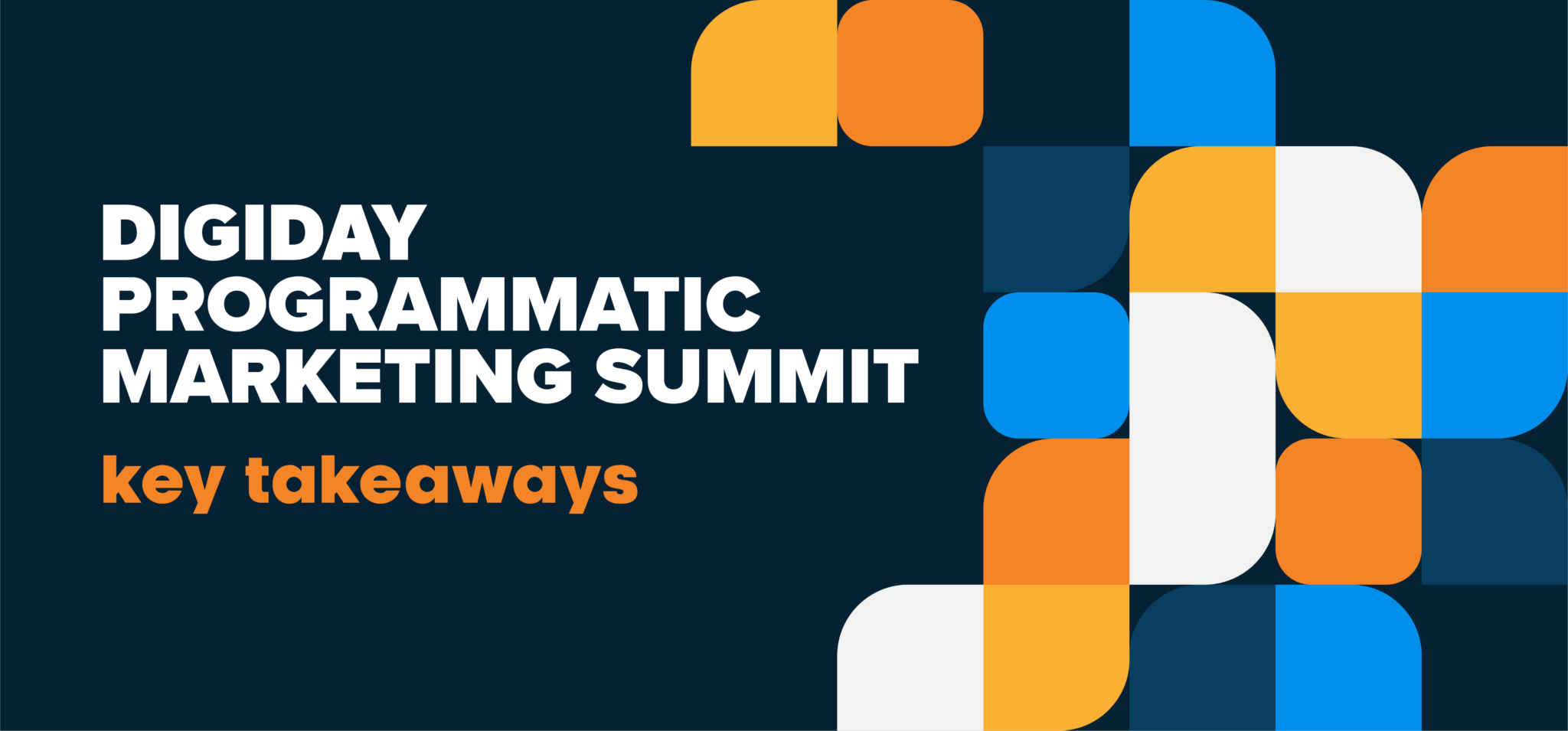We recently had the opportunity to attend the Digiday Programmatic Marketing Summit where we heard from industry leaders, Sara Jerde and Tim Peterson of Digiday discuss the state of the digital marketing industry and the challenges it faces. They spoke on the ongoing demise of third-party cookies and how advertisers need to revise their measurement and attribution models. Sara and Tim also mentioned the use of clean rooms for safeguarding customer data and the importance of complying with data protection laws. Additionally, they hit on the biggest item of the conference, the role of artificial intelligence in ad tech and its potential to open new opportunities and automate tasks.
With the industry abuzz with innovation, progress, and technology, we’re sharing our key takeaways.
Advanced Capabilities in Programmatic Marketing
JiYoung Kim, President, North America at GroupM Nexus, discussed what’s on the horizon for marketing agencies and their clients. She posed the question, “has the programmatic industry really advanced in the last 10 years?” As it pertains to ad spend, yes. In the current state of media, ad spend has more than doubled in the last 10 years. Ad spend is projected to reach $326 billion within the United States alone. 70% of ad spend will be on digital tactics and 90% of that will be through programmatic activation.
Through her experience and research, Kim noted that the digital industry has a great amount of wasted spend trying to reach target audiences. To help paint a picture and quantify waste, Kim informed the audience that a total of $2 million dollars is spent to reach a single user for them to perform an action across the industry. The reason is that advertisers have shifted their focus from how to understand the user to how to automate programmatic media for the user. We have spent too much time trying to convince marketers the value of programmatic. Now the mentality is that we won, but we have not taken the time to understand how to personalize creative messaging efficiently.
How can advertisers better understand their audience? According to Kim, we can deliver a better ad experience by:
- Evaluating potential changes with the deprecation of third-party cookies
- Leveraging AI to tap into the potential of programmatic media buying
- Imagining behavior sets in a model or cohort, similar to ChatGPT
How Old School Thinking Hurt Programmatic CTV
Phil Case, President and Chief Client Officer of Max Connect Marketing challenged old school notions that hinder programmatic CTV advertising. Currently, advertisers and brands have a mass buying mentality for TV that has an upper funnel approach. This is largely due to how linear TV has historically been bought, with brands struggling to understand that we can target regions and markets on a more granular level. Case explains that a hurdle for programmatic is that dollars are shifting from linear TV to CTV in a streaming format. What he means by streaming format is buying directly from different publishers.
Advertisers buy CTV with a traditional mindset because they desire their ads to be shown in a specific daypart or programming. Brands buying TV or CTV prefer having the ability to pick their daypart because they value having the same ad shown to everyone at the same time. An example is Roku pitching their Primetime Reach Guarantee capability. Advertisers can set up a deal with Roku to run their ad to the full target audience during primetime hours. With this strategy, Roku gets to keep more of the budget and spend.
Educating advertisers on the “new” way of thinking about buying TV on a granular level can be challenging. We need to shift the mindset from buying upfront inventory to real-time inventory. Programmatic CTV can be used for both brand awareness and performance; however, there are challenges the industry faces when measuring CTV performance. According to Case, there’s still a “connective tissue” that doesn’t exist with CTV and attribution, making it difficult to show and prove performance. However, the industry has started to bridge the gap between CTV and attribution. Roku has been pioneering the advancement of attribution with their hardware and software. Hulu has started to run create interactive ads where users can request to send the advertised offer to their email. Streaming partners that do not require a login or subscription will be limited and will not have that capability and as a result, that data will not be collected.
What’s important with positioning CTV is setting expectations on how it will fall in the full marketing strategy. The question we should ask is: How is it affecting brand lift and how has it enhanced conversion from other campaigns?
Context-Based Strategies Can Benefit Media Executions
Marketers are facing challenges with advertisers increasing their use of third-party audiences, causing contextual targeting to take a back seat. Contextual targeting can help by providing better ad viewability and inferring a user’s interests based on the content they consume. The content environment of an ad can impact brand perception, with consumers finding ads that align with content more favorable and memorable. Contextual ads with Page Context AI outperform third-party segments and cut CPA by 30%. Tactics to consider include non-branded keywords, competitive keywords, branded keywords, and targeting niche contexts. The key takeaway is that AI makes contexts smarter, and contextual targeting can easily build brand affinity while avoiding privacy headaches.
Navigating the Intersection of Marketing and Social Responsibility
Channel Factory is a minority-owned and purpose-driven organization primarily focused on the suitability space. They have contributed to global standards in regard to brand safety and guidelines; however, there are still challenges we face in the industry. Unconscious bias still exists within the advertising space that creates inequality. We can combat these challenges with the three pillars of conscious advertising:
- DE&I
- Sustainability
- Civic society
The one thing these pillars have in common is that they are all deemed unsuitable by standard practices. The pillars create a bigger problem when trying to eliminate a category within a contextual line item.
What we must do is evolve with technology and societal norms and expectations. People are more conscious and aware of what’s happening around the world. Making a difference means ensuring our advertising technology is following suit.
- 59% of consumers say it’s important that the companies they buy from actively promote diversity and inclusion
- 82% of respondents to WARC’s Global Marketers Toolkit survey say DE&I is important to their 2023 marketing strategies
However, there’s still a big problem we face. Diverse creators are often defunded, not included, or hard to reach. Three quarters of LGBTQIA+ stories were found nonmonetizable according to a study by CHEQ. Therefore, there’s a large amount of creators that are in marginalized communities that can’t make a living from platforms like YouTube.
Why is the industry the way it is and how do we fix it? There are three areas and pain points of digital:
- Chaos: The analogy to explain this is everything is everywhere all at once when it comes to digital advertising. The upfronts created problems for brands around fraud, non-viewable ads, limited ad experience, and misaligned content across the board.
- Cautious: The industry put policies and procedures in place, such as: viewability standards, brand safety, keyword exclusions/bans, and limitations to the number of languages. There are also unintended consequences that come with safety such as: block lists that over block, inclusion lists that are not inclusive but are actually exclusive by design, news being underfunded, and virality beating positivity. We need to address rampant misinformation caused by AI sourcing from the open web and combine being responsible and safe with inclusive and equitable investments.
- Conscious: Only by being conscious of all aspects of a creator, their channel, and their video content can we avoid negative impact and increase positive reach. Being conscious means being aware of both ourselves and what exists around us. We need to notice, consider, or appraise, and be concerned, interested, or involved. At Butler/Till, we are committed to building a more equitable and inclusive future not just for our employee-owners, but for our space as responsible advertisers and marketers.
So, what does this mean for Advertisers? While brand safety is important for brands, regularly checking blocklists to ensure you are not over blocking content that aligns with your brand’s values can help you reach a richer and more inclusive audience segment. At Butler/Till, we’re committed to working with our clients to spend at least 10% or more of their programmatic media budgets with purpose-driven partners and suppliers. By providing media budgets to minority-owned and sustainable publishers, we’re helping diversify spend, intersect results and responsibility, and are helping build a more equitable advertising ecosystem, rich in innovation and opportunity.





